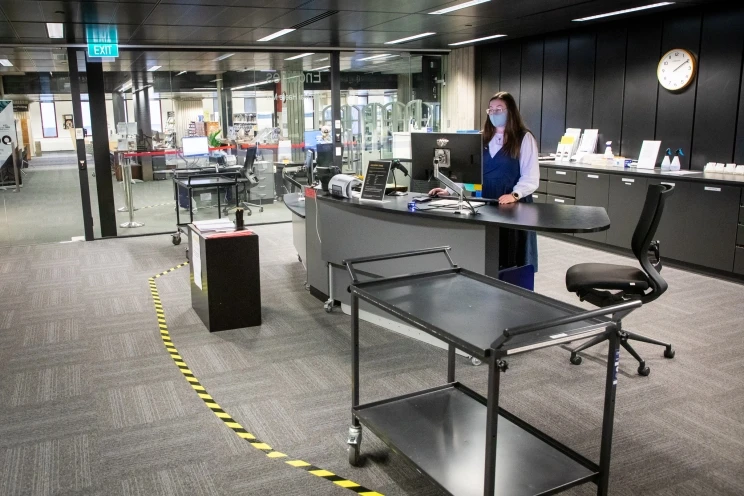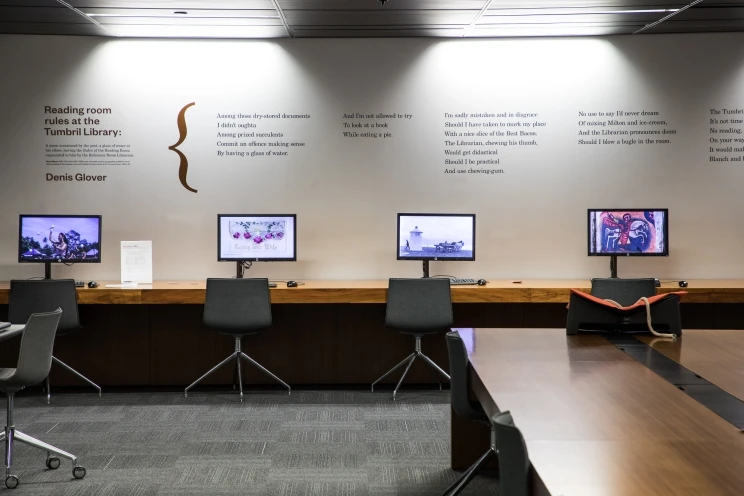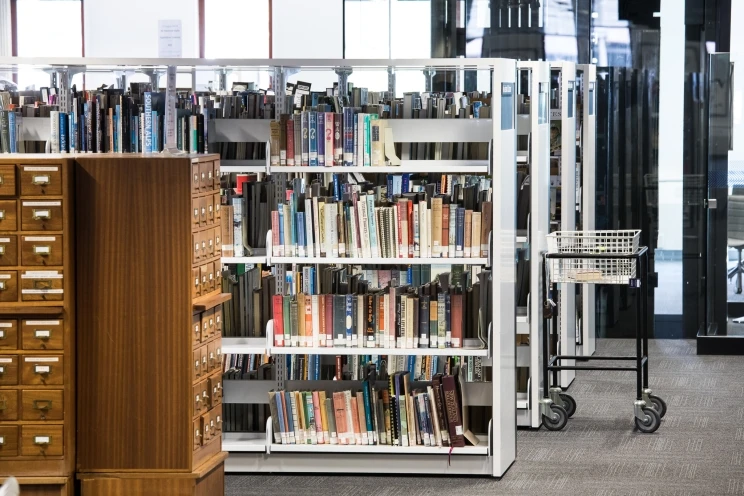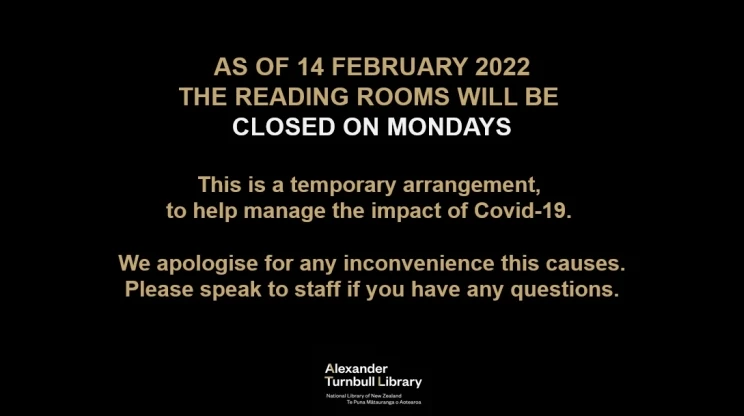“Monday, Monday….” Turnbull and the Omicron surge
Sharing our experiences of delivering reading room services during the ongoing COVID pandemic.
Delivering reading room services in a pandemic
Delivering reading room services has been a challenge this year. Vaccine passes, traffic light settings, a Parliament precinct occupation, and community transmission of the Omicron variant of COVID-19 have all affected our ability to serve researchers onsite at the National Library in Wellington.
In February, we announced the temporary measure of closing the reading rooms on Mondays with the promise of a monthly review to determine when we would resume normal services.
This post describes how we are faring with the ongoing COVID situation and what we are learning from the monthly reviews.
Low and slow
Our approach has been to keep the rate of COVID-19 transmission as low as possible in the Library to protect people from the virus and to provide some certainty for researchers planning to visit the reading rooms. To do this, we used a range of tactics that combined to slow the spread of the virus. These included vaccination mandates, mask-wearing, physical distancing, and surveillance testing.

Librarian Audrey Stratford behind the desk in the Katherine Mansfield reading room. Photo: Mark Beatty
Vaccination mandates
Vaccination mandates were introduced at the Library; not only for the public we serve but for those of us that work here. From early-January until mid-April, all visitors to the National Library building in Wellington had to show a vaccine pass to gain entry and all of us who work in the building were required to be fully vaccinated.
Mask wearing and physical distancing
We wear masks in the reading rooms and ask that researchers do too. Staff are provided with N95 masks, and visitors at the front door are offered blue surgical face masks if they have forgotten their own. We know the prolonged use of masks can be unpleasant, but thankfully the overwhelming majority of onsite visitors have complied with this without issue. We also wear masks behind the scenes in common work areas, especially when we are moving about the building.
Visitors to the reading rooms will have noticed there are fewer seats than normal. That is because we removed chairs to ensure that seated researchers could stay distanced from one another. We have also asked that researchers maintain a two-metre distance from the reference desk. Inevitably though this hasn’t always been practical, and when we’re helping with tricky microfilm readers or interpreting what’s on computer screens, distancing hasn’t always been possible.

The distancing measures in place in the Katherine Mansfield reading room. Photo: Mark Beatty
Surveillance testing
In March, we introduced surveillance testing for staff members who deliver or support frontline service. This is an ‘opt-in’ programme where we supply RAT (Rapid Antigen Test) testing kits with the expectation that on Tuesdays and Thursdays we self-administer the tests. This programme has been effective at detecting early instances of infection before individuals became symptomatic or infectious. Early detection and prompt isolation have reduced the risk of unchecked spread in the workplace.
Reducing reading room hours so staff can stay at home when sick
Perhaps the hardest thing to manage has been planning for staff absences due to self-isolation requirements and household contacts as well as regular coughs and colds circulating in the community.
It takes a whole team to run our reading room services. Each week 42 Turnbull Library staff are rostered to cover 92 shifts across three service points. On top of that, there’s a hive of activity behind the scenes to retrieve collection items from the stacks and prepare them for delivery in time for readers who’ve requested them.
It’s carefully choreographed so when one person is away the whole team must adjust. Staff that don’t normally serve in the reading rooms have stepped up to be trained as substitutes, and experienced staff have taken on extra shifts to cover the rosters.

The Katherine Mansfield reading room with Denis Glover poem adorning the wall, Reading room rules at the Tumbril Library. Photo: Mark Beatty
A temporary measure
In February we were optimistic that we’d soon be back to normal opening hours and could not have predicted that reading rooms would still be closed on Mondays in August. Each month we’ve reviewed our decision, taking into consideration official COVID-19 guidance, researcher sentiment, and staff availability.
What are we learning from monthly reviews?
The monthly reviews to assess readiness for resuming Monday reading room hours are proving useful for monitoring and providing a record of how the COVID pandemic has progressed and how we’ve responded.
Most of our regular researchers have adjusted to the Monday closures and spread their visits to the other days. We acknowledge though that for some of our users, reducing the reading rooms by one day a week continues to be an inconvenience and an ongoing source of frustration.
Communicating the unexpected is tricky
We’ve used the National Library website to notify the temporary change in opening hours along with fliers in the reading rooms and onsite signage. Some visitors, fortunately not many, have been caught unaware not suspecting any change until they’ve arrived onsite. Others thought that the information was not being kept up to date as the message remained the same from month to month.
We emailed key research stakeholder groups in early February to let them know that opening hours were changing and again in April to check in and invite their feedback. The few responses we got back were supportive and understanding, with a view that avoiding public spaces right now seemed sensible and that having reliable hours was helpful.
Some certainty helps navigate the unpredictable
We have been able to avoid opening and closing the reading rooms at short notice so that visitors have been able to plan with confidence. Our commitment to retaining opening hours Tuesday – Friday and Saturday mornings has also helped us to forecast and make internal arrangements.
We’ve changed from a monthly roster to a fortnightly roster to better accommodate for staff absences. For most staff the 7-day, isolation period is not sufficient for recovery from the virus, and a phased return to work has been supported to manage fatigue which has been a common effect. Casual staffing and staff doing extra shifts have covered the shortfall. But only just.
Knowing with certainty that staff are rostered to cover critical onsite services has given staff some flexibility to manage their working arrangements such as working from home on tasks that can be done online.

The General reading room of the Alexander Turnbull Library. Photo: Mark Beatty
Services at a distance have carried on
The ‘Ask a librarian’ online service has carried on successfully throughout the pandemic. Even when the National Library building was closed, our Librarians were able to access collections to complete many requests on behalf of researchers at a distance.
Where to from here?
As we hunker down for this latest COVID-19 wave and new variants and subvariants keep coming we are shifting our thinking to a longer-term horizon. Our focus continues to be on keeping people safe in the reading rooms and offering access to our unique collections and quality research support services. We know that even with distance services ramping up, the reading rooms are still the only way that certain collections can be accessed and used.
While indoor settings continue to be risky for researchers, we are turning our attention to those aspects of our service and items from our collection that might be delivered online. Later this month we’ll be asking people what it is that they value about our ‘Ask a librarian’ service and our online events so that we can perhaps identify opportunities to adapt and enhance our distance offer.
We’d value your input. Watch out for the online surveys or send your feedback or suggestions to Information@natlib.govt.nz
“Monday, Monday, …. still no guarantee….”
In the meantime, the reading rooms continue to be closed on Mondays. We acknowledge this is frustrating for some users and thank researchers for their patience. Like the rest of the country, we look forward to getting back to a more usual state of business just as soon as we can.

"Closed on Mondays". Signage displayed outside the reading rooms on Mondays to alert onsite visitors to the change.
The blog foregrounds the librarians’ health concerns, not the impact of the pandemic on the blog. It also shows how events overtook the library. Communication about the reduced reading room hours was delivered by the library in an ad hoc, unsupported and random way.